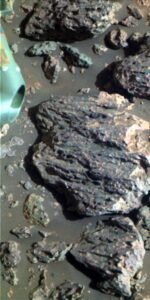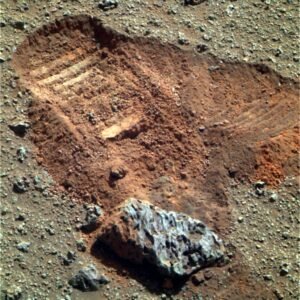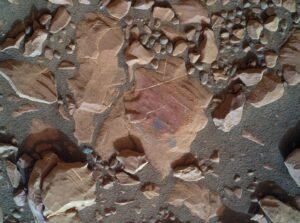Latest Posts
A new gravity map of Mars indicates a porous crust
NASA scientists have discovered that the density of the Martian crust is lower than expected, and this could have major implications for understanding the internal structure of the planet itself and its evolution… This post has been automatically translated. See the original post here.
Leave Mars to the robots!
Finally a nice article that tries to sensitize the public opinion on the importance to avoid any biological contamination of the planet Mars by bacteria and viruses that would be inevitably imported by a possible expedition with human crew!Obviously Robert Zubrin has immediately thundered against this article calling it “idiotic” (see https://twitter.com/robert_zubrin/status/990728572716269568) :“Another idiotic article saying we should keep humans off Mars to protect science. We know far more about Earth than any other planet because we are here. Keeping humans off #Mars is a way to stop #science, not protect it. #Space”It is useless to try to understand how he can afford such “shootings” with impunity, I only hope that “whoever is in charge” will respond adequately and finally silence such reckless!!! Please MAXIMUM SHARING!!! This post has been automatically translated. See the original post here.
Opportunity Sol 5070, April 29, 2018
Between 13:29:39 UTC and 13:30:54 UTC Opportunity’s Pancam takes three images with narrow band filters in the three basic colors, from which it was possible to derive this beautiful true color image of the Martian soil and rocks.In this case, the original images (especially in the green and blue) have a high level of “noise” and so I applied a median filter to all three colors to eliminate spurious dots.Still very interesting color variations, not only on the rocks but also on the ground! RGB HD image processed: https://image.ibb.co/g2ZrEH/Oppy_Sol5070.jpg Original BN images: Red (735nm with 20nm bandwidth)13:29:39 UTC14:45:58 LTST https://mars.nasa.gov/mer/gallery/all/1/p/5070/1P578275429ESFD2DNP2509L2M1.HTML Green (535nm with 20nm bandwidth)13:30:12 UTC14:46:30 LTST https://mars.nasa.gov/mer/gallery/all/1/p/5070/1P578275462ESFD2DNP2509L5M1.HTML Blue (432nm with 32nm bandwidth)13:30:54 UTC14:47:11 LTST https://mars.nasa.gov/mer/gallery/all/1/p/5070/1P578275504ESFD2DNP2509L7M1.HTML This post has been automatically translated. See the original post here.
Why the polar regions of Mars are of extreme interest to astrobiology and why we have not yet been able to explore them
Very few times have I read an article so rich in detail and so well done that it captured my attention in this way!In this article we discuss all the ways in which liquid water can form on Mars and how it can maintain the liquid state for long periods with or without added salts.But not only that, it also addresses in a very serious way the problem of sterilization of the probes, in order to avoid contamination, with a wealth of details never seen before!It is really a “Must” for those who want to understand how life could thrive on Mars even in the current conditions, but especially for those who still doubt that the liquid water on Mars may be much more abundant than some “popularizers” would like to believe!Definitely a treat!!! 😉 This post has been automatically translated. See the original post here.
The first ExoMars image taken from the new orbit
Reached the final circular orbit at 400 km altitude, begins the scientific phase of the ExoMars mission…Now the dances begin! 😀 😉 This post has been automatically translated. See the original post here.
Opportunity Sol 5062, April 21, 2018
Between 08:38:50 UTC and 08:40:23 UTC Opportunity’s Pancam takes three images with narrowband filters in the three basic colors, from which it was possible to derive this extraordinary true-color image of the furrow created by one of Opportunity’s wheels.In this case, the original images (especially in green and blue) have a high level of “noise” and so I applied a median filter to all three colors to eliminate spurious dots.The curious aspect is that the sand appears decidedly reddish just below the surface, while the layer exposed to the air turns green!Obviously, as long as the greenish spots are visible on the surface of a rock (as in the one visible below) it is impossible to determine from a simple photo to what extent such colorations are part of the mineralogical nature of the rock itself or surface “encrustations”. But in this case it is clear that the greenish coloration of the soil affects only the surface layer of the soil itself.It seems clear to me that in this case the cause of the greenish coloration is to be found in some kind of chemical-physical interaction between the soil and the atmosphere! RGB HD image processed: https://image.ibb.co/bvKyZH/Oppy_Sol5062.jpg Original BN images: Red (735nm with 20nm bandwidth)08:38:50 UTC15:10:07 LTST https://mars.nasa.gov/mer/gallery/all/1/p/5062/1P577566823EFFD283P2362L2M1.HTML Green (535nm with 20nm bandwidth)08:39:24 UTC15:10:40 LTST https://mars.nasa.gov/mer/gallery/all/1/p/5062/1P577566857EFFD283P2362L5M1.HTML Blue (432nm with 32nm Bandwidth)08:40:23 UTC15:11:38 LTST https://mars.nasa.gov/mer/gallery/all/1/p/5062/1P577566916EFFD283P2362L7M1.HTML This post has been automatically translated. See the original post here.
Curiosity Sol 2028, April 21, 2018
At 20:00:55 UTC, 11:46:10 local daylight time, Mastcam Right captures this rock of great interest.As usual, the original image has been subjected to white balance and a slight increase in color saturation and contrast.In the rock in the foreground, but not only, there are layers and textures that are anything but regular, which would require a very thorough analysis.Even, according to Luigi Bignami (see post https://www.facebook.com/photo.php?fbid=10210906869657034&set=a.10202431362694657.1073741829.1511498797&type=3) the photo would show structures much more similar to fossils than to simple sedimentary or volcanic structures.Obviously, the seriousness and culture of Dr. Bignami lead him to propose his opinion from a hypothetical and questionable point of view, a sign of a great professional seriousness that I appreciate and admire!However, I would like to emphasize that I personally share fully the observations of Dr. Bignami, which is why I propose this processed version in which you can better appreciate the details described in his post. HD processed image: https://image.ibb.co/d5sQDc/Curiosity_Sol2029_01.jpg Original image (raw): https://mars.jpl.nasa.gov/msl/multimedia/raw/?rawid=2029MR0107090010902961E01_DXXX&s=2029 This post has been automatically translated. See the original post here.
Luigi Bignami writes “REALLY PARTICULAR
This photograph recently arrived on Earth (within the last few hours) and it’s a rock photographed by Curiosity in the Gale crater. I don’t want to exaggerate, but it is really amazing. If it were a terrestrial rock I would say it is rich in “fossils”. We are on Mars and therefore I do not think they are fossils the structures that you see, but I can not really understand what they are.See the curved shape? There are of all the measures. I do not find a rational explanation from the sedimentary or volcanological point of view to explain them. I leave all the hypotheses open…” I agree! This post has been automatically translated. See the original post here.
Curiosity Sol 2029, April 22, 2018.
At 00:26:25 UTC, 16:04:35 local solar time, the Mars Hand Lens Imager (MAHLI) imaged this peculiar formation of rocks of various shapes.The large central rock was first cleaned with the rotary abrasion tool and then hit in at least nine places with the laser for spectroscopic analysis.The image was taken from a distance of 26.4 cm with a resolution of 101.3 microns per pixel.To improve color rendition, the original was subjected to white balance and a slight increase in color saturation and contrast. HD processed image: https://image.ibb.co/cVU1Jc/Curiosity_Sol2029.jpg Original image: https://mars.jpl.nasa.gov/msl/multimedia/raw/?rawid=2029MH0001900010801470C00_DXXX&s=2029 This post has been automatically translated. See the original post here.
Mars imaged in good visibility conditions on April 17
The great astrophotographer Damian Peach gives us another beautiful image of Mars taken through the telescope.From the left, we can see the color image followed by the b/w image in red, green and blue.In the image taken with the blue filter is easier to see the many cloud formations visible a bit ‘everywhere.Clearly visible also Solis Lacus, as well as the Valle Marineris in the center of the disc. This post has been automatically translated. See the original post here.



